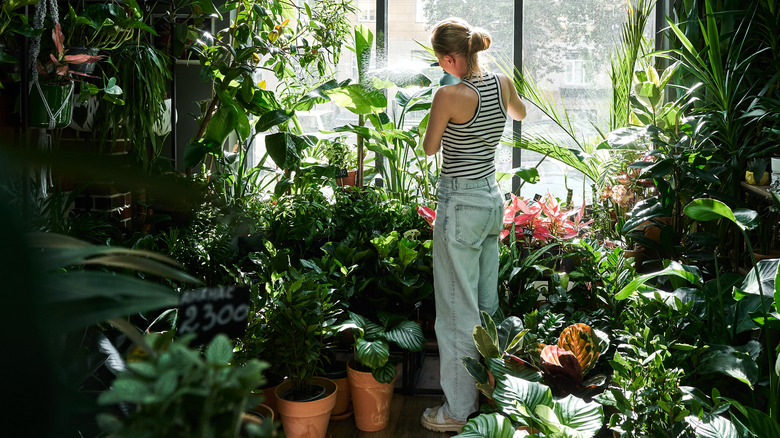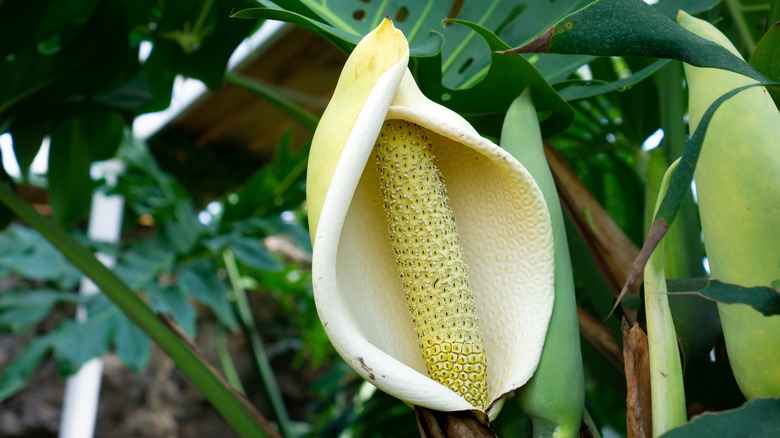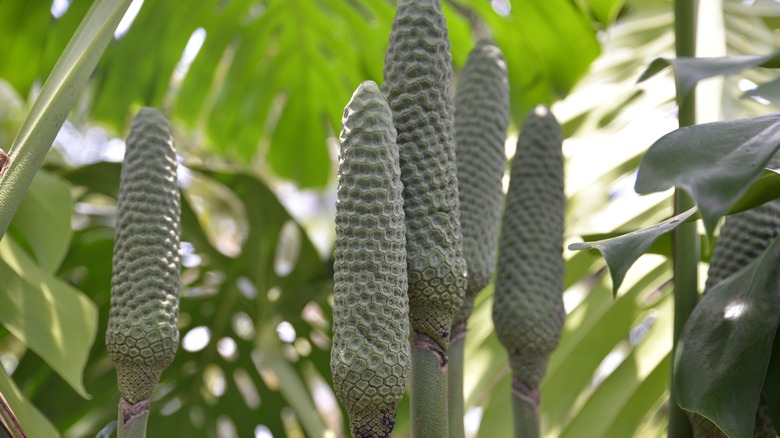The Common Houseplant You Didn't Realize Produces Fruit (But There's A Catch)
Houseplants have many benefits, from keeping your home's air clean to absorbing moisture — but feeding you typically isn't one of them. In fact, some houseplants are poisonous to humans, including poinsettias and peace lilies. But one houseplant in particular can produce a fruit with a delicious flavor: Monstera deliciosa, also known as the Swiss cheese plant for its famously fenestrated leaves. The catch? It's extremely rare for a monstera to grow fruit indoors.
Monstera deliciosa is also sometimes nicknamed the "fruit salad plant" — it tastes like a combination of multiple tropical fruits, including banana, pineapple, and mango. Known as monsteras or cerimans, the fruit looks like a green corn cob and is about 9 inches long. It's rich in potassium and vitamin C and can be eaten fresh, but is also used to flavor drinks and foods. While you can find cerimans for sale online and in areas where monsteras naturally thrive outdoors, getting your houseplant to fruit is a different matter. To get its fruit, first you have to get its flowers.
How to get your monstera to bloom
Indoor monsteras may struggle to grow to full size or grow their signature Swiss cheese leaves, let alone bloom. And without flowers, they can't produce fruit. Monsteras are native to rainforests in Central America and look remarkably different than their houseplant counterparts. In the wild, they climb along trees as vines to grow to impressive heights, whereas indoors, they may easily collapse under their own weight without support. Other factors, like light, humidity, water, and nutrients, are also different in a natural setting than indoors. Most monstera houseplants aren't large enough and don't get enough light to flower and fruit.
That doesn't mean it's impossible. Once a monstera plant is at least three years old, it's capable of blooming. You can encourage it by mimicking its natural growing conditions. Stake your monstera with a moss pole and provide plenty of bright, indirect sunlight. Humidity levels should stay between 40% and 60% with temperatures between 60 and 86 degrees Fahrenheit. If you live in a warm, humid tropical or subtropical environment, consider placing your monsteras outside. Fertilize your monstera once a month during warm months, with a fertilizer high in potassium. Proper watering is also important; monsteras like to dry out a bit between waterings and need good drainage. If you're lucky enough to get fruit eventually, the flavor will be influenced by your monstera's growing conditions.
How to go from flowers to fruits
After a monstera has bloomed, there's an additional obstacle before you can get fruit: pollination. In the wild, insects would pollinate the monstera plant. Unless your monstera is outdoors, you will have to hand-pollinate, a tricky process that involves collecting pollen and dabbing it onto the female parts of the flowers. This helps the monstera produce fruits and seeds.
Monstera fruits take about a year after flowering to be mature enough to pick. You can tell it's ready when the green kernels start to expand outward. The fruit has to be properly harvested and prepared to be safe to eat — like peace lilies, monsteras are high in oxalic acid, and eating an unripe fruit (or leaves or stems) can result in painful throat irritation, nausea, diarrhea, and vomiting. You can either place the fruit in a paper bag or in a glass of water to ripen it. The green kernels will peel away from the part of the fruit that's ripe and safe to eat, revealing the pale edible flesh underneath. If you're lucky enough to finally taste a monstera, all that hard work will easily be worth it.


